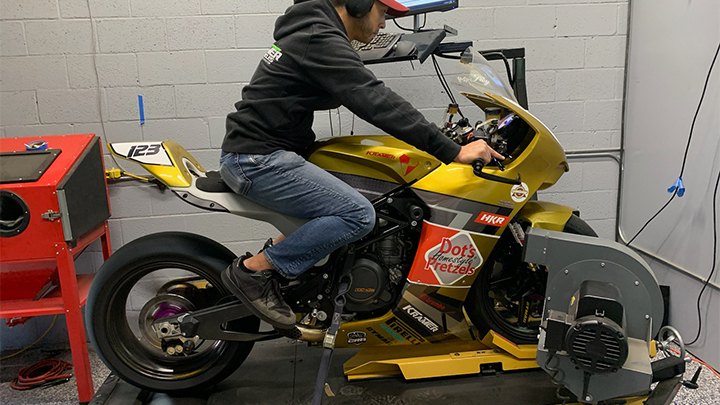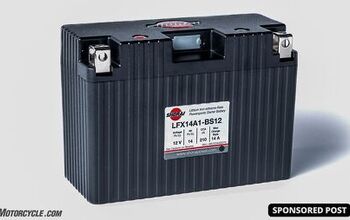ETS JSK8 Race Fuel Review

Liquid horsepower for a little performance edge
I realize a review on specialty race gas probably won’t appeal to most of you, but as odd as it may sound, the thing I do to relax and get away from testing motorcycles during the week… is get away and race motorcycles on the weekends. In case you were wondering, my personal racebike (in fact, it’s the only bike I currently own) is a Kramer HKR-EVO2S, powered by KTM’s mighty LC4 690cc Single. Mine’s been breathed on a little, but with only one cylinder going up against the likes of Aprilia RS660s, Yamaha R7s, Suzuki SV650s, and other middleweight twins, I could use any power advantage I can get.
I resisted the urge to switch to race gas for a long time. I can get pump gas right down the street from my house, and even premium gas in California seems like a comparative bargain. In contrast, race gas has to come from specialty retailers (or sometimes at the racetrack). The harder pill to swallow is it’s expensive – costing $20/gallon or more! With race gas comes extra steps like ensuring it’s stored in a cool area, and for certain fuels, draining your fuel tank after you’re done riding (or once you get home) as the chemicals in race gas if left to sit for long periods of time, can cause havoc on an engine and fuel system.
Nonetheless, curiosity got the better of me, and in my quest to keep up with bikes that should be faster than me on paper, I succumbed to the race gas brotherhood. After consulting with Yann Labia of ETS Fuels, he suggested I give ETS JSK8 a try. He recommended JSK8 for three reasons: First, he was confident JSK8 would yield some performance gains on my Kramer without the need to retune it (though he strongly advised that I do). Second, JSK8 is a mild to moderate fuel, meaning it won’t harm my engine or fuel system if I get lazy and forget to drain it for a couple days (it’s also ethanol free, so won’t gum up in my fuel system, either). Lastly, JSK8 is a more affordable option in the ETS lineup, with a five-gallon pail retailing for $120 at the time of this writing – though that’s still a hefty $24/gallon.
If you wanted to know more about fuel, I wrote a separate article explaining everything you need to know about fuel here. For those who like to nerd out about fuel specs, JSK8 is an unleaded fuel with a RON rating of 104 and MON rating of 90, which averages out to an octane rating of 97. It’s 3.6% oxygen by weight, which is approximately the same as pump gas and why ETS says remapping your bike isn’t critical (but wouldn’t hurt), as the stock ECU won’t need to recalibrate much, if at all.
JSK8, like all ETS fuels, maintains very high batch-to-batch consistency with a proprietary blend of hydrocarbons and molecules to offer a fuel that’s well suited for high combustion speeds (which is what you need for high-revving motorcycle engines) and offers high combustion energy – otherwise known as horsepower. Its 97 octane rating can be used on normally aspirated or forced induction engines as long as the compression ratio is lower than 14.7:1
Yeah, but does it work?
With the details out of the way, the next question is naturally how the JSK8 performs. Well, as the path to easy horsepower goes, it doesn’t get much easier than this – it’s literally a tank of gas. During practice for one particular race weekend, I had been using standard pump gas, as that was already in my tank. Once it was time to refill, I poured in the JSK8. Immediately, I noticed better throttle response and I was able to accelerate with other motorcycles I wasn't able to before with regular pump gas. Best of all, I was able to lower my lap time by one full second compared to the previous practice session on pump gas. I was sold by this point, and by the end of the weekend, I was able to win one race and finished second in the other, capturing the fastest lap of the race in the process.
Now, I still haven’t recalibrated my Kramer for JSK8 because I got to thinking: if JSK8 is good, what does ETS have that’s better? This led me to its PX11 fuel, a leaded fuel with a 110 RON rating and 98 MON rating, for an average octane rating of 104. That’s a high octane rating, due in part to the lead, but don’t forget that octane does not equal power (and in fact, too much octane isn’t good either). The chemistry inside the fuel is what brings power, as well as a high oxygen content. In the case of PX11, it’s 7.7% oxygen by volume – more than double that of JSK8. This certainly requires ECU recalibration to account for the oxygen content and high combustion speeds (usually an adjustment of ignition timing). Even though I didn’t change anything on my bike, I added PX11 anyway to see what difference it would make. These were the results:
A 1.8 horsepower difference between JSK8 and PX11 doesn’t look like much, I get it. Looking at the power chart after about 6600 rpm until redline, the graph plateaus. It seems as though the engine can't breathe well up top which leads to the flatlining. Nonetheless, my little single-cylinder engine sees a 2.6% increase in horsepower. Also, compare both of those fuels to the control 100-octane pump fuel and the difference isn't bad – a 2.2% increase for JSK8 and a 4.8% bump for PX11. Looking beyond the peak power numbers, the engine performance across the mid-range looks much better with either ETS fuel, especially the JSK8. This is important, even on a race bike, as it translates to how well a bike can jump out of corners. On tight, technical tracks this advantage will be even more beneficial. The critical thing to remember is, again, that the control bike has not been calibrated for PX11 and its huge oxygen content. I’d expect a notable difference with proper fuel tuning done to my bike for PX11.
Ultimately, taking the leap from pump gas to JSK8 proved to be a bigger advantage than I realized it would be. But, to me, that advantage is only worth it if you’re going racing and are looking for any edge you can. Twenty-odd bucks per gallon of the good stuff means, unless you’re loaded in greenbacks and/or you have to run it for some reason, there’s no point throwing money away in gas if you’re rolling around in practice. If you’re looking for a race gas that’s relatively affordable (as far as race gas goes), requires little to no modifications to your motorcycle, and will get you a modest bump in power, give the JSK8 from ETS your consideration.
We are committed to finding, researching, and recommending the best products. We earn commissions from purchases you make using the retail links in our product reviews. Learn more about how this works.
Become a Motorcycle.com insider. Get the latest motorcycle news first by subscribing to our newsletter here.

Troy's been riding motorcycles and writing about them since 2006, getting his start at Rider Magazine. From there, he moved to Sport Rider Magazine before finally landing at Motorcycle.com in 2011. A lifelong gearhead who didn't fully immerse himself in motorcycles until his teenage years, Troy's interests have always been in technology, performance, and going fast. Naturally, racing was the perfect avenue to combine all three. Troy has been racing nearly as long as he's been riding and has competed at the AMA national level. He's also won multiple club races throughout the country, culminating in a Utah Sport Bike Association championship in 2011. He has been invited as a guest instructor for the Yamaha Champions Riding School, and when he's not out riding, he's either wrenching on bikes or watching MotoGP.
More by Troy Siahaan


































Comments
Join the conversation
Very interesting article on racing fuel, thank you.
Something it reminded me of, was being in the motorcycle business for 49 years.
We carried racing fuel for many years with no extra insurance charges.
Then they began charging and got so high they forced us to quit carrying racing fuel.
William Wolfe
Depends on if you prefer fixed costs to variable costs. Mechanical improvement cost can be spread over miles used. Gas consumption cost increases can’t be absorbed through increased usage. I’m sure there is a happy medium in there somewhere. Damn that gas is expensive.